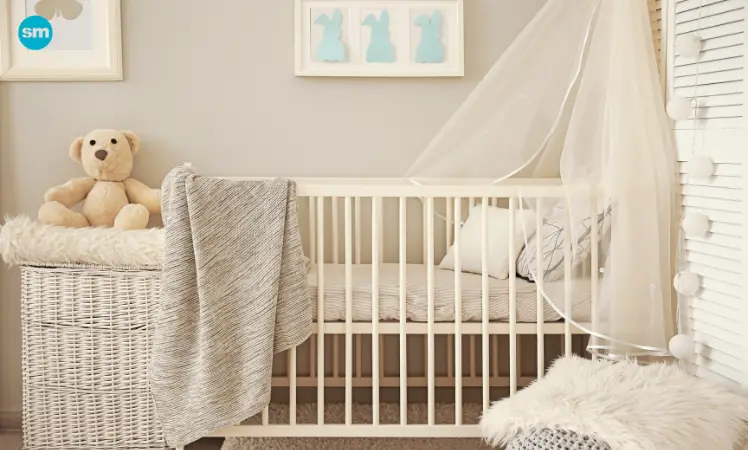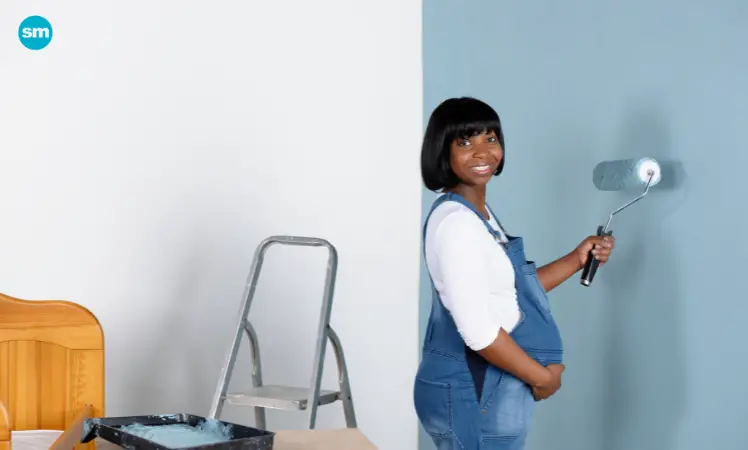Last Updated on February 1, 2024 by Lori Pace
You want a unique crib that is customized for your baby’s one-in-a million beautiful baby. A crib that has been used a few times can be repainted for a very affordable price. It’s also environmentally friendly because you are reusing it! Are you inspired to decorate your baby’s nursery with paint? It’s possible to paint a crib for your baby. If you adhere to certain guidelines regarding crib material, paint selection, ventilation, and other safety considerations, it can be done safely in most cases.
Is It Safe To Paint A Crib Made Of Wood?

To make a baby-safe painted crib, ensure that the crib material does not crack or peel after being painted. Most cribs made from wood can be painted. To determine if painting is an option, you can consult the manufacturer.
What Type Of Paint To Use On A Baby Crib
Here are some things to keep in mind when choosing the right paint color for your crib.
- Choose non-toxic paint (no silicates, lead or lead) that is free of volatile organic compounds (VOCs). While the original paint may not contain VOCs, VOCs can be added to tint the paint to your desired color. SQAQMD113 regulates VOCs in paints, both in the base and in tinting agents. It may be prudent to look at a “Waterborne Interior-Acrylic-Enamel” which meets these standards.
- Paints certified EN71-3 and ASTM F963-17 will give you greater security. These certifications indicate that paints are safe for children’s toys.
- Use sealants and paint additives not approved for children’s toys and cribs.
- Personal preference will determine the best finish for you. Semi-gloss paint is popular because of its visual appeal, ease of maintenance, and long lasting durability.
6 Steps On How To Safely Paint A Crib
- You can place a drop cloth outside or in a garage, and then secure each corner with an object. Make sure the crib is dry, clean and free from dirt or grime.
- Although disassembling the crib may give you a professional look, it is not necessary. All surfaces should be lightly sanded (or scuffed). To avoid inhaling dust, wear a mask. It is not necessary to remove the surface. Just roughen it up until the paint adheres properly. A medium (180#), fine (220#), or fine (320#) grit sponge will suffice.
- Use a tack cloth to remove any sanding dust.
- You should apply at least two coats of nontoxic paint. Wait 4-6 hours between coats. You can personalize the crib by painting it with your child’s name, a quote or nursery rhyme, stars or any other design that you like. A high-quality 100% nylon bristle brush will give you the best results. Many people make the error of purchasing the highest quality paint possible and then using a poor brush to apply it. This conforms to ASTM D 4236, particularly in relation to oral toxicity, skin irritation, and respiratory effects.
- This is a step that you don’t need to take. It’s unnecessary to apply a clear coat after the paint has dried completely. Clear coats will not add more value to your job than any other coat of paint. The finish should last if you used a non-toxic, high-quality paint like Lullaby Paints.
- Non-toxic paints can be used as soon as the last coat has dried. Your baby can then use the room/crib.
Frequently Asked Questions:
Do I need to prime?
Priming is only usually necessary when you’re painting bare wood, or making drastic color changes (black to white).
What finish should I choose for a crib (eggshell, gloss, semi-gloss)?
Although Semi-Gloss is the most popular, any of these three options are ideal for functional purposes. All are equally durable and tough.
I have already primed my crib. Do I still have to sand it down so the paint will stick?
No sanding is necessary if the crib has been primed. If the crib has a glossy finish, you would typically only need to scuff-sand it. It doesn’t have to be sanded all the way, just enough to roughen it up.
Does this method work on compressed wood?
Most cases, yes. You will only need to apply a coat of Primer before you paint. You must ensure that the wood is dry and clean.


